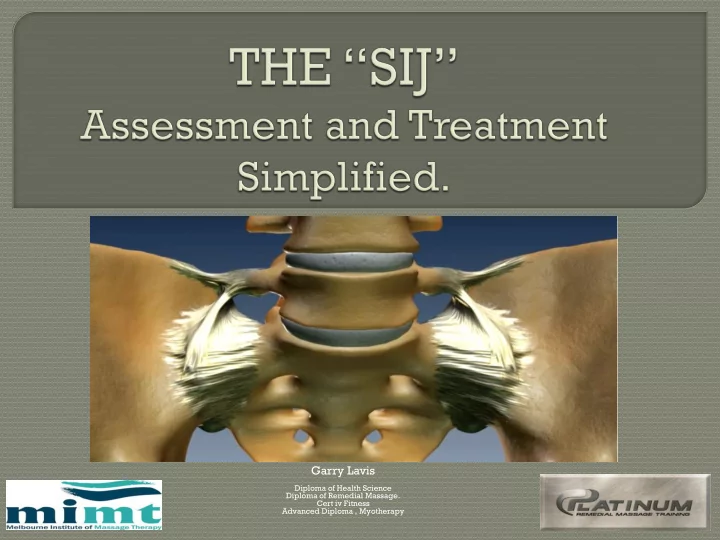

Garry Lavis Diploma of Health Science Diploma of Remedial Massage. Cert iv Fitness Advanced Diploma , Myotherapy
STRUCTURE BIOMECHANICS Movement produced by The connection between distal locations of the body. the lumbar spine and the Approx 5 degrees rotation. pelvis. Approx 2mm translation. The SI Joint is a load Vulnerable to shear during bearing joint and distribute rotation and translation. weight from the spine to Joint compresses during the lower extremities via body the hip joints. movement.(loadbearing) Concave sacral surface. Although normal SIJ movement is small, it is Convex illiac surface. essential for pain free Highly ligamentus joint. functionality.
SIJ Dysfunction refers to the abnormal function of the SIJ, (Hypomobility or Hypermobility) at the Joint which places stresses on structures in or around it. Therefor SIJ Dysfunction may contribute to lumbar, buttock, hamstring or groin pain. Brukner & Khan CSM 4th edition
CONCAVE SACRAL SURFACE CONVEX ILIAC SURFACE https://www.youtube.com/watch?v=D6NTMgWCSaU
NUTATION COUNTER NUTATION A forward tilt/rotation A Backwards (flexion)of the sacrum in tilt/rotation(extension) of reference to the adjacent the sacrum in reference to ilium. the adjacent ilium. Nutation of the Sacrum is Counter Nutation is considered a locked/ considered an unlocked loadbearing position for position and allows stability articulation of the inominate.
Nutation Counternutation Locked Unlocked https://www.google.com.au/search?hl=en&site=imghp&tbm=isch &source=hp&biw=1366&bih=643&q=articulations+of+the+SIJ&oq= articulations+of+the+SIJ&g
TRANSLATION GAIT. In the normal gait cycle, combined movements occur conversely in the right and left innominate and spine. Translation or forced closure (locking) occurs on the weight bearing side and an unlocking occurs on the opposite side during the swing phase.
Integral to the biomechanics of SIJ stability is the self locking mechanism. The ability of the SIJ to self lock, occurs through two types of closure. Form Closure and Force Closure. Form Closure describes how specifically shaped, closely fitting contacts provide inherent stability independent of external load. Force Closure describes how external compression forces add additional stability. The combination of form closure and force closure establishes stability in the sacroiliac joint.
https://www.youtube.com/watch?v=D6NTMgWCSaU
https://www.youtube.com/watch?v=D6NTMgWCSaU
SACROTUBEROUS LONG DORSAL SACROILIAC LIGAMENT. LIGAMENT. Sacrum to Ischial 3 rd and 4 th Sacrum to PSIS Tuberosity. A tort or tight A tort or tight Long Sacrotuberous Ligament Sacroiliac Ligament will will restrict nutation of the restrict counternutation of sacrum. the sacrum. Direct attachment to the Direct attachment to TLF biceps Femoris muscle. and Multifitus. Self Bracing
STABILIZERS https://www.youtube.com/watch?v=D6NTMgWCSaU
Multifidus. Transverse Abdominis. Internal Oblique. Pelvic Floor.
Lumbar Hip SIJ
• If it is SHORT – LENGTHEN it. • If it is HARD – SOFTEN it. • If it is LAZY – STIMULATE it. • If it is STIFF – MOBILISE it. • If is WEAK – STRENGTHEN it.
Recommend
More recommend